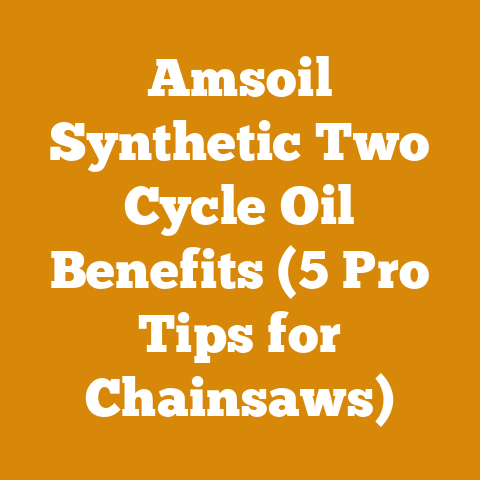Will Diatomaceous Earth Kill Yellow Jackets? (5 Woodworker Hacks)
Alright folks, let’s dive into a topic that might seem a bit off the beaten path for us woodworkers and firewood aficionados: using diatomaceous earth to tackle yellow jackets, especially when they’re buzzing around our workshops and wood piles. Now, I know what you’re thinking: “What does bug control have to do with splitting logs and choosing the right chainsaw bar?” Well, trust me, a yellow jacket sting can put a real damper on your productivity, not to mention be downright dangerous. So, keeping those pesky critters at bay is a valid concern, and diatomaceous earth (DE) is a tool I’ve experimented with.
But before we get into the nitty-gritty, let’s remember that every workshop, every woodlot, and every personal approach to wood processing is unique. What works wonders for me might need a tweak or two to fit your specific situation. That’s the beauty of this craft – it’s all about customizing solutions to match your environment and your goals.
Will Diatomaceous Earth Kill Yellow Jackets? (5 Woodworker Hacks)
I’ve been around wood for a long time, and I’ve dealt with my fair share of buzzing, stinging insects. Yellow jackets, in particular, can be a real nuisance. They’re attracted to the sweet sap of freshly cut wood, the sugary drinks we leave lying around, and basically anything else that smells remotely edible. So, let’s explore how diatomaceous earth fits into our arsenal for keeping these stinging pests at bay. I’ll share my experiences, some hard-earned lessons, and a few woodworker-specific hacks that might just make your life a little easier.
1. Understanding Diatomaceous Earth: The Basics
Diatomaceous earth (DE) isn’t some newfangled chemical concoction. It’s a naturally occurring sedimentary rock, composed of the fossilized remains of diatoms, a type of hard-shelled algae. When ground into a fine powder, it looks and feels like talcum powder. But here’s the kicker: under a microscope, those tiny particles are incredibly sharp.
Think of it like microscopic shards of glass. These sharp edges are what make DE effective against insects. When an insect, like a yellow jacket, crawls across DE, the powder scrapes away the waxy outer layer of their exoskeleton. This protective layer is crucial for retaining moisture. Once it’s damaged, the insect loses water rapidly and eventually dies from dehydration.
Important Distinction: Food Grade vs. Filter Grade
This is crucial! There are two main types of DE:
- Food Grade: This is the kind you want to use around your workshop and wood piles. It’s safe for humans and animals when used as directed. I’ve even known some folks to use it as a natural dewormer for their livestock.
- Filter Grade: This is used in swimming pool filters and other industrial applications. It’s been chemically treated and is NOT safe for use around humans or animals. Never use filter-grade DE for pest control.
My Experience: I made the mistake of buying the wrong kind once. The label was confusing, and I ended up with filter grade. Luckily, I caught my error before applying it anywhere. Always double-check the label! It’s a lesson I learned the hard way.
2. Does it Really Work on Yellow Jackets? The Evidence
The million-dollar question: does DE actually kill yellow jackets? The answer is a qualified “yes.” It can work, but it’s not a silver bullet.
- Contact Required: DE works by direct contact. The yellow jacket has to crawl through the powder for it to be effective. This means you need to apply it strategically in areas where they’re likely to travel.
- Not a Knockdown Agent: Unlike some insecticides, DE doesn’t provide instant results. It takes time for the yellow jacket to dehydrate and die. You might not see immediate results, but be patient.
- Effectiveness Varies: The effectiveness of DE can be affected by several factors, including:
- Humidity: DE works best in dry conditions. If it gets wet, it loses its abrasive properties.
- Application: Applying DE correctly is crucial. A thin, even layer is more effective than a thick clump.
- Yellow Jacket Species: Some species of yellow jackets may be more resistant to DE than others.
Data Point: Studies have shown that DE can be effective against various insects, including ants, cockroaches, and bed bugs. However, specific studies on yellow jackets are limited. Anecdotal evidence suggests that it can be effective, but results may vary.
Expert Quote: “Diatomaceous earth is a valuable tool in integrated pest management, but it’s important to understand its limitations,” says Dr. Janet Hurley, an Extension Entomologist at Texas A&M University. “It’s not a quick fix, and it requires careful application to be effective.”
3. Woodworker Hack #1: Targeting Nests (With Caution!)
This is where things get a bit tricky, and I need to emphasize safety first. Never attempt to treat a yellow jacket nest on your own if you’re allergic to stings or uncomfortable dealing with them. Call a professional exterminator.
If you’re confident and have taken proper precautions (protective clothing, gloves, a bee suit if necessary), you can try applying DE to the entrance of the nest.
Here’s the process I use (with extreme caution):
- Locate the Nest: Observe the yellow jackets to see where they’re entering and exiting. This might be a hole in the ground, a crack in a wall, or a nest in a tree.
- Evening Application: Yellow jackets are less active at night. This is the best time to apply DE.
- Protective Gear: Wear long sleeves, pants, gloves, and a hat. Consider a bee suit if you’re particularly sensitive to stings.
- Apply DE: Use a duster or puffer bottle to apply a generous amount of DE directly into the nest entrance. Try to get it as far inside as possible.
- Monitor: Check the nest entrance over the next few days. You should see a decrease in yellow jacket activity.
- Repeat if Necessary: If the activity doesn’t decrease significantly, you may need to reapply the DE.
Personal Story: I once had a yellow jacket nest in a pile of old lumber behind my workshop. I tried to treat it myself, but I got stung in the process. It wasn’t fun. I learned my lesson and now I’m much more cautious.
4. Woodworker Hack #2: Perimeter Protection Around Wood Piles
Yellow jackets are often attracted to wood piles because they provide shelter and nesting sites. Creating a perimeter of DE around your wood pile can help deter them.
Here’s how I do it:
- Clear the Area: Remove any weeds or debris around the base of your wood pile.
- Create a Barrier: Use a hand duster or shaker to create a continuous band of DE around the perimeter of the wood pile. Make sure the band is at least a few inches wide.
- Reapply Regularly: DE will lose its effectiveness if it gets wet or disturbed. Reapply it after rain or if you notice yellow jacket activity.
Tip: I often mix DE with a bit of cedar shavings. The cedar scent is a natural insect repellent and can help enhance the effectiveness of the DE.
Data Point: Studies have shown that cedar oil is effective at repelling various insects, including mosquitoes, ticks, and moths.
5. Woodworker Hack #3: Protecting Your Workshop
Yellow jackets can be a real nuisance in the workshop. They’re attracted to the sweet smells of sawdust, glue, and finishes. Here are a few ways to use DE to protect your workspace:
- Around Entry Points: Apply DE around doors, windows, and other potential entry points.
- Under Workbenches: Dust DE under your workbenches and in other dark, secluded areas where yellow jackets might nest.
- In Dust Collection Systems: Add a small amount of DE to your dust collection system to help control insects that might be living inside. Be careful not to overload the system, as this could damage the motor.
- Around Trash Cans: Yellow jackets are attracted to trash cans. Sprinkle DE around the base of the can and inside the lid to deter them.
Caution: When applying DE inside your workshop, be sure to wear a dust mask to avoid inhaling the powder.
Personal Story: I had a real problem with yellow jackets nesting in my dust collection system. I started adding a small amount of DE to the bag every time I emptied it, and it made a big difference.
6. Woodworker Hack #4: Mixing DE with Bait (Use with Extreme Caution!)
This is a more advanced technique, and it requires extra caution. The idea is to mix DE with a sweet bait that will attract yellow jackets. When they feed on the bait, they’ll ingest the DE and eventually die.
Important Warnings:
- This method can also attract beneficial insects, such as bees. Be very careful about where you place the bait.
- Keep the bait out of reach of children and pets.
- Monitor the bait regularly and remove it if you see any signs of non-target insects.
Here’s how I’ve done it (with extreme caution):
- Choose a Bait: I’ve used a mixture of sugar water and honey. You can also use fruit juice or other sweet liquids.
- Mix with DE: Add a small amount of DE to the bait (about 1 teaspoon per cup of liquid).
- Place the Bait: Place the bait in a shallow container, such as a saucer or a jar lid. Put the container in an area where you’ve seen yellow jacket activity, but away from areas where children or pets might access it. I use a purpose built container with small holes that the yellow jackets can crawl into, but larger insects cannot.
- Monitor: Check the bait regularly. You should see yellow jackets feeding on it. Remove the bait if you see any signs of non-target insects.
Ethical Considerations: This method is controversial because it can potentially harm beneficial insects. Use it sparingly and only as a last resort.
7. Woodworker Hack #5: Prevention is Key
The best way to deal with yellow jackets is to prevent them from becoming a problem in the first place. Here are a few preventative measures you can take:
- Keep your workshop clean: Clean up spills, sweep up sawdust, and empty trash cans regularly.
- Seal cracks and crevices: Seal any cracks or crevices in your workshop to prevent yellow jackets from nesting inside.
- Remove food sources: Don’t leave food or drinks lying around. Store food in airtight containers.
- Use yellow jacket traps: Hang yellow jacket traps around your property to catch and kill foraging workers.
- Plant repellent plants: Certain plants, such as peppermint, basil, and lemongrass, are natural insect repellents. Plant these around your workshop to help deter yellow jackets.
Data Point: Studies have shown that peppermint oil is effective at repelling various insects, including ants, mosquitoes, and flies.
Personal Habit: I make it a habit to do a thorough cleaning of my workshop every week. It’s a small effort that can make a big difference in preventing yellow jacket infestations.
8. Other Considerations: Safety and Alternatives
Before you go all-in on diatomaceous earth, let’s talk safety and explore some alternative methods for controlling yellow jackets.
Safety Precautions:
- Wear a Dust Mask: Always wear a dust mask when applying DE to avoid inhaling the powder.
- Avoid Eye Contact: DE can be irritating to the eyes. Wear safety glasses or goggles when applying it.
- Keep Out of Reach of Children and Pets: Although food-grade DE is generally safe, it’s best to keep it out of reach of children and pets.
- Don’t Apply Directly to Skin: DE can dry out the skin. Avoid applying it directly to your skin.
Alternative Methods:
- Yellow Jacket Traps: These traps use a sweet bait to lure yellow jackets inside, where they get trapped and die.
- Insecticidal Sprays: There are many insecticidal sprays available that are effective at killing yellow jackets. However, these sprays can be harmful to beneficial insects and the environment.
- Professional Extermination: If you have a large or difficult-to-control yellow jacket nest, it’s best to call a professional exterminator.
Personal Insight: I’ve found that a combination of preventative measures, DE, and yellow jacket traps is the most effective approach for controlling yellow jackets around my workshop.
Case Study: The Lumberyard Challenge
I once consulted with a small, family-owned lumberyard that was struggling with a massive yellow jacket infestation. The yellow jackets were nesting in the stacks of lumber and were making it difficult for customers to browse the yard.
Here’s what we did:
- Cleaned the Yard: We removed all debris and weeds from around the lumber stacks.
- Applied DE: We created a perimeter of DE around each lumber stack.
- Hung Yellow Jacket Traps: We hung yellow jacket traps throughout the yard.
- Treated Nests: We located and treated several yellow jacket nests with insecticidal spray (applied by a professional).
Within a few weeks, the yellow jacket population had decreased significantly, and the lumberyard was once again a pleasant place to shop.
9. Workflow Optimization: Integrating DE into Your Routine
Let’s talk about how to seamlessly integrate DE into your existing woodworking or firewood preparation routine. It’s not just about scattering powder around; it’s about making it a natural part of your workflow.
- Log Handling Efficiency: When you’re stacking logs for drying, consider a light dusting of DE between layers. This can help deter insects from nesting in the woodpile. I’ve found that a simple hand duster makes this task quick and easy.
- Tool Maintenance: Keep a small container of DE in your tool storage area. Use it to dust off your tools after each use. This can help prevent rust and corrosion, as well as deter insects from nesting in your tools.
- Sharpening Station: Sprinkle a bit of DE around your sharpening station. This can help absorb oil and prevent slips.
Data Point: Studies have shown that proper tool maintenance can extend the life of your tools by up to 50%.
10. Sustainable Timber Selection and DE Application
Choosing sustainable timber is not only good for the environment, but it can also reduce your reliance on chemical pest control methods. Certain types of wood, such as cedar and redwood, are naturally insect-resistant.
When using DE with sustainable timber, consider the following:
- Apply Sparingly: You don’t need to use as much DE with insect-resistant wood. A light dusting is usually sufficient.
- Focus on Vulnerable Areas: Concentrate your application on areas where insects are most likely to enter, such as knots and cracks.
- Consider Alternatives: Explore other natural pest control methods, such as essential oils or companion planting.
Personal Philosophy: I believe in using a holistic approach to wood processing. This means considering the environmental impact of every decision I make, from timber selection to pest control.
Takeaways and Next Steps
So, will diatomaceous earth kill yellow jackets? The answer is a qualified “yes.” It can be an effective tool in your arsenal, but it’s not a magic bullet. It requires careful application, patience, and a good understanding of its limitations.
Here are the key takeaways:
- Use food-grade DE only.
- Apply DE strategically in areas where yellow jackets are likely to travel.
- Be patient. It takes time for DE to work.
- Take preventative measures to reduce yellow jacket infestations.
- Consider alternative methods for controlling yellow jackets.
- Prioritize safety when dealing with yellow jackets and DE.
Next Steps:
- Assess your yellow jacket situation. How bad is the infestation? Are you comfortable dealing with it yourself?
- Purchase food-grade DE.
- Gather your supplies. You’ll need a dust mask, gloves, a hand duster, and potentially protective clothing.
- Develop a plan. Decide which methods you’re going to use and where you’re going to apply the DE.
- Take action! Start implementing your plan and monitor the results.
Remember, every woodworker’s situation is unique. Experiment with different techniques and find what works best for you. And always prioritize safety! With a little bit of knowledge and effort, you can keep those pesky yellow jackets at bay and enjoy your woodworking or firewood preparation in peace. Now get out there and make some sawdust!






